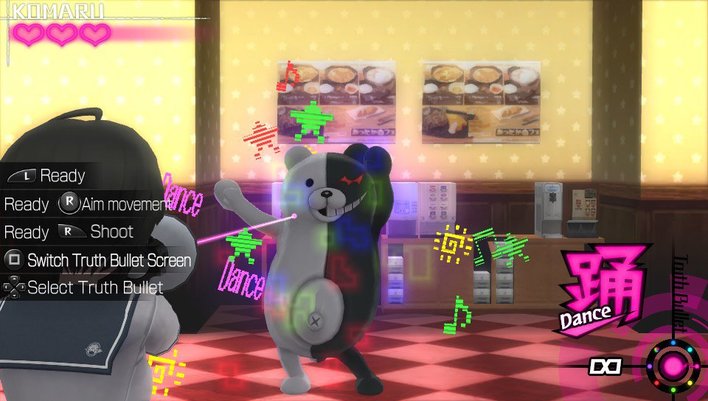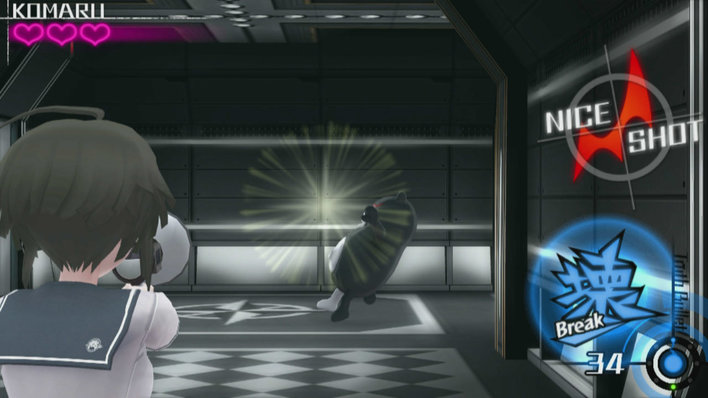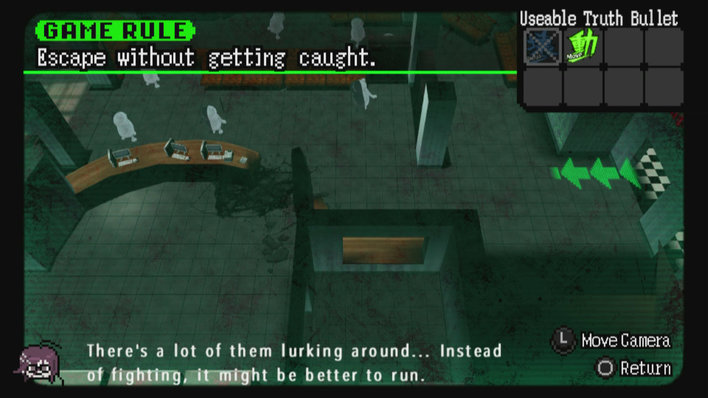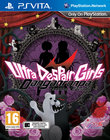We'd probably best start this by saying we may be a little bit biased here. After all, we've never been that fond of kids - or at least their parents - especially those who seem that little bit too lax with the discipline. While little Johnny runs rings around the table and tries his best to trip over a waiter, and Susan screams her head off, while her doting parents just sit smiling at her in an "isn't she cute" way, there's plenty that p's us off about badly behaved brats. So the idea of a game in which the children lead a revolution, and murder their parents, with the idea being to create a world free of adults, where children can live safe lives, free from the tyranny of the adult kind of rings true with us. After all, the parents had it coming.
Still, this is the tale behind Danganronpa Another Episode: Ultra Despair Girls, a game with an unwieldy name that marks a bit of a change of pace for the Danganronpa series. With two instalments under its belt already - the excellent Danganronpa: Trigger Happy Havoc, and the slightly less excellent Danganronpa 2: Goodbye Despair, the series very quickly rose to the top of the list of the very best visual novels of all time, by providing a genuinely thrilling choose-your-own-adventure style experience that had us up until the early hours of the morning on more than one occasion. Weaving a narrative that meant you just had to find out what happened next, as a class full of students were locked in a school, with the only way to escape being to kill each other - and get away with it - it was a game that spawned a thousand questions, and laid the foundations for a franchise. The twist for Ultra Despair Girls? It's a third person shooter.

Just Dance!
But wait! While that may sound like sacrilege at first, Ultra Despair Girls isn't actually too much of a departure from the winning Danganronpa formula. While there's no murder mysteries to solve, there is an intricate storyline telling the tale of two girls stuck in the middle of the ongoing war between the forces of hope and despair - with several familiar characters showing their faces along the way.
For those who haven't played a Danganronpa game before - well, you should probably stop reading this review here, as there be spoilers ahead - big, unavoidable spoilers we can't actually avoid talking about without spoiling at least one of the major plot points from the first game. You have been warned. In fact, as Ultra Despair Girls is set in-between the events of Danganronpa 1 and 2, it manages to contain spoilers for both games - and particularly big ones from the first - so, if you don't want to spoil the events of the greatest Vita game of all time, you'll want to be sure you've played both of them first.

That's one winning 'tash...
Set in the heart of an industrial district known as Towa City, the game follows the story of two very different girls. The first, Komaru Naegi is the younger sister of the first game's protagonist, Makoto. While her bro was an "ultimate" student who became known as the ultimate hope, unfortunately for Komaru, she's no ultimate anything - as she wastes no time in pointing out, repeatedly. To her, she's just your normal, average, every day girl, with nothing special about her whatsoever. The other girl in the duo is the decidedly less normal Toko Fukawa, a writing prodigy who leads an amazing double life. For when Toko sees blood, she transforms into Genocide Jill, a serial killer with a fetish for pretty boys, who likes nothing more than to slice them up, and pin them to a wall with her scissors. An average school girl, and a genocidal maniac? Sounds like a recipe for a great road trip.
Despite their two very different back stories, however, both Toko and Komaru find themselves in the same situation - trapped in the middle of Towa City, in the midst of the children's uprising. Lead by a five strong group of kids known as the Warriors of Hope - a group who've been sucked in by the remnants of despair (essentially the baddies of the Danganronpa series) - the children are controlling an entire army of Monokuma robots, and have decided to make a game out of hunting you down, as part of some misguided plot to make an example of you to the rest of the adults. And so in true Japanese plot style, you're released into Towa City with an explosive bracelet strapped around your wrist, and a gang of robots hunting you down, as you try not only to survive - but to bring down the children's plot.

It's well worth taking time out to line up a good shot and get the insta-kill
Unlike the previous Danganronpa games, how you do this is a lot more action packed than before. Armed with a magical megaphone that fires code in the form of an electromagnetic pulse (can you tell Danganronpa isn't the most realistic of games?), it's up to you to lead the fight back against the Monokuma hordes by, well, yelling at them. Although (perhaps disappointingly) you don't actually have to yell at your Vita in real life (you only have to press the R Button), you have a variety of "truth bullets" on hand that you can use to take down the Monokumas with, with each type of ammunition giving your megaphone a different power.
Your standard one, Break is both numerous and fairly effective, especially if you happen to hit the Monokuma-bots in their one weak point - their glowing red eye - but there are plenty of other choices here too, for the megaphone firing connoisseur. Dance does what it says on the tin, giving any Monokumas it touches an infective urge to get down and boogie, Move lets you interact with things, Knockback sends any nearby enemies flying (which is incredibly handy should you find yourself in a pinch), Burn fires off a machine gun style burst, while Detect lets you scan the environment for hidden, ultra violet pointers, which may hint at where the collectibles are...
Most of the time, though, it won't really matter what truth bullets you choose, as so long as you're taking down the Monokumas as quick as they come, you're OK. With your time split between essential story exposition in visual novel style sections, exploring Towa City as you make your way from underground base to tech-savvy tower to Monokuma factory, and facing off against hordes of Monokumas, there's plenty of variety here too, and never really a dull moment.
The Monokumas themselves aren't quite as decidedly normal and bear shaped as you may expect, either. Instead, there are countless different classes of foes here for you to deal with, with each one requiring a slightly different strategy. Guard Monokuma carries a riot shield and wears a protective helmet, making him it tricky to hit his weak spot; Siren Monokuma has a siren on his head, which gets set off as soon as he spots you, calling other Monokumas closer; while Bomber Monokuma explodes after he's hit...
However, from time to time, you'll get the chance to put your truth bullet skills to the test, and have to clear what are known as game rooms. Here, you're presented with a collection of Monokumas of different types and classes, and are given a suitably challenging objective you have to complete - usually either "sneak past without being spotted", or "destroy them all at once". And these are about as tricky as they sound.

Plan your moves carefully.
Before each game room, you're shown a CCTV style overview of the area, which shows you where the Monokumas are, and what truth bullets you can use. With only certain types of truth bullet permitted, it's up to you to try and figure out what you have to shoot at who, when, to get all the Monokumas together, or to take them all out at once. And that can be quite the challenge. Whether you're shooting a Siren Monokuma to set his alarm off, and draw the other 'kumas closer, or even in the later stages of the game, taking direct control of them with another one of your powerful truth bullets, positioning them in just the right place on a patch of water that they'll be electrocuted when you fire your shock bullet, these take a heck of a lot of forward planning to figure out. If you prefer your games to be more brawny and less brainy, you can always run through these areas all guns blazing - but then you won't get a good rank on the level, and those trophies will be forever out of reach...
But while the puzzle sections are pretty good, and the whole megaphone idea is crazy enough it somehow works, Ultra Despair Girls' trump card is far and away its story, which carries the game from start to finish. While it doesn't have quite the same "oh God what's going to happen next" feeling as the visual novels, there's still enough intrigue to keep you going here. In a nutshell, the game is essentially a "coming of age" style story in the midst of a civil war, as both Toko and Komaru learn to cope on their own, and lean on each other for support - Komaru as she finds her self confidence, and Toko as she learns to control her mass murderous split-personality, and maybe even make a friend along the way... It's a touching tale, and the closer it gets to the end, the more you find yourself willing them on, and hoping it'll all somehow come off - while at the same time also worrying that one of them is going to pop their clogs, in true Danganronpa fashion. Equally Danganronpa-esque, though, is how dark the story gets from time to time. While we don't want to give anything away, it's safe to say that the Warriors of Hope have a very good set of reasons for leading a children's uprising, with some pretty drastic sob stories in there, including child prostitution. We told you it got dark...
It's also probably worth mentioning that if you're not all that great at third person shooters, there's plenty of bits in here that you'll like too - and several ways to make your game easier. There are a loads of collectibles to be found, and while some are offer an extra insight into the story, like books and notes, each of which reveals a little snippet about the story and the residents of Towa City, there are also several new powers and upgrades for your megaphone and characters hidden around the town. Perhaps brilliantly, what this means is that those who prefer the slower, more Danganronpa style experience can go through the game at their own pace, hunt out the collectibles, and end up buffing their characters quicker. So they'll find the abilities that give you extra hearts quicker, and have an easier game because of it. It's a nice touch, to say the least. Of course, it's not all Komaru, either - if you really find yourself a pinch, pressing Triangle lets you call on the help of Genocide Jill, who will pretty much slice through anything in sight should you mash the Square button. It's well worth remembering when you find yourself surrounded by Monokumas.
In all, then, Danganronpa: Ultra Despair Girls is a great example of how important a story is to a game. Bringing the whole experience together, and making an otherwise OK game a great one, this is a must play for anyone who's a fan of the series - but probably isn't the best starting point if you have yet to play either of the other games. So, if you like the sound of what you've read here, you have two things to do. First, buy and play Danganronpa: Trigger Happy Havoc. Second, buy and play Danganronpa 2: Goodbye Despair. And then, and only then, get Ultra Despair Girls, and prepare yourself for plot twists galore in a game that takes you deeper into the Danganronpa lore than ever before, tying up a few loose ends while opening plenty more. A worthwhile departure, then - but here's hoping the recently announced Danganronpa V3 is a return to the games of old.
Format Reviewed: PS Vita

















